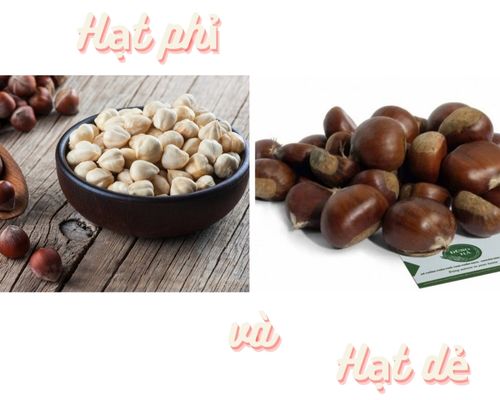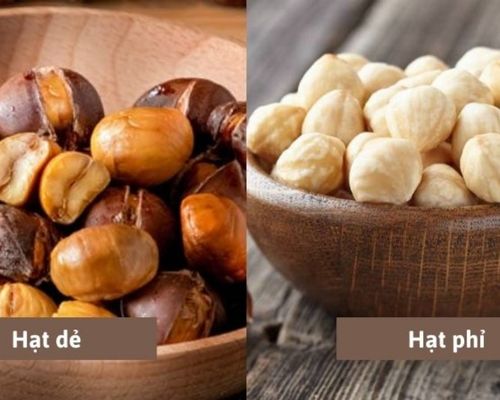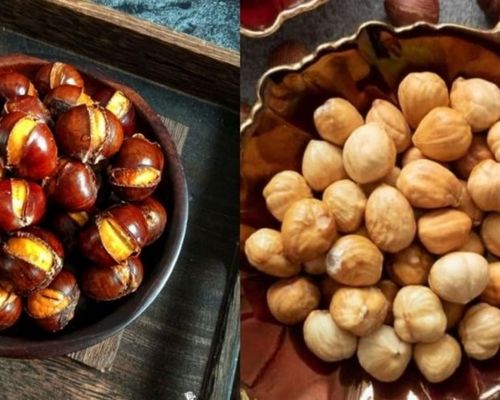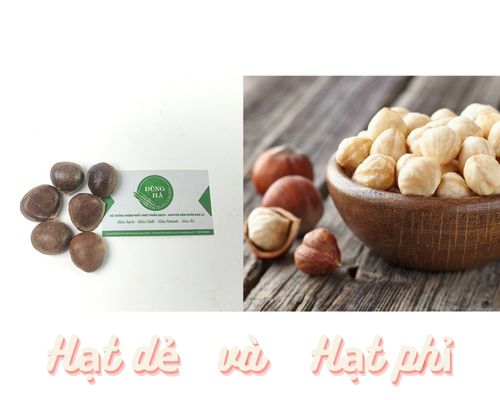Tin tức
Hazelnuts and chestnuts are similar and different – Dry food
Hazelnuts and chestnuts are a kind of nutritious nuts that are extremely good for consumers’ health. Both nuts can be used directly or added to cake recipes. So do you know what is the difference between hazelnuts and chestnuts? Let’s find out with Dung Ha Dry Food.
1. What are hazelnuts and chestnuts?
1.1 What are hazelnuts?

In 28g of hazelnuts contain:
- Calories: 176Kcal
- Fat: 17g
- Protein: 4.2g
- Carbohydrates: 4.7g
- Fiber: 2.7g
- Vitamin E: 21%
- Thamine: 12%
- Magnesium: 12%
- Copper: 24%
- Manganese: 87%
1.2 What are pistachios?
In 100g of pistachios contains:
- Calories: 97Kcal
- Fat: 0.1g
- Carbohydrates: 23.9g
- Fiber: 3g
- Protein: 2g
- Potassium: 17%
- Manganese: 17%
- Bronze: 16%
- Vitamin B6: 16%
- Riboflavin: 12%
2. What’s the difference between hazelnuts and hazelnuts?
2.1 Characteristics
With hazelnuts:
- The kernel is small, white, and crunchy like a walnut. Dried and can be stored for a long time
- Has a light scent similar to the smell of earth
With pistachios:
- The kernel is yellow, the skin is thin. Roasted, the inside is very soft, spongy, not hard
- Has a slight buttery aroma, very delicious to eat
View more products American Pistachios
2.2 Applications
With hazelnuts:
- Make cooking oil, make cakes, stir-fry
With chestnuts:
- Eat directly after boiling or roasting

2.3 Price of hazelnuts and chestnuts
The easiest way to distinguish hazelnuts from hazelnuts is by the price.
- In Vietnam, the price of hazelnuts often fluctuates, up and down. At one point, the price of hazelnuts reached a price of 120,000 VND/kg. But sometimes, the price of hazelnuts drops to only about 100,000 VND/kg.
Currently, the Vietnamese chestnut market is very large. Chestnuts currently have the following types: Sapa forest chestnuts, Cao Bang chestnuts, Thai chestnuts, Japanese chestnuts. Each type of chestnut has a large difference in price. Among these chestnuts, Cao Bang chestnut and Sapa chestnut are the most popular. Specifically, chestnut prices are as follows:
- Price of Cao Bang chestnuts on the market: 85,000 VND/kg. The price of Cao Bang chestnuts at Dung Ha is on promotion: 80,000 VND/kg
- Price of forest chestnuts in Sapa: 200,000 VND/kg
- Price of Thai chestnuts: 90,000 VND – 110,000 VND/kg
- Price of Japanese chestnuts: 520,000 VND/kg
See more: Where to sell delicious American pistachios at Dry Food
3. What are the similarities between hazelnuts and chestnuts?
Are 2 series of nutritious seeds that are beneficial to the user’s health. The benefits that these two nuts bring are up to 90% similar. Specifically, hazelnuts and chestnuts are similar in:
3.1 Provide enough nutrients
Hazelnuts and chestnuts contain essential nutrients to keep the body healthy. The nutrients can be mentioned as: Protein, Vitamin E, B6, Phosphorus, Magnesium, Zinc. In addition, there are also an extremely large number of substances such as omega-6 and omega-3 fatty acids that are extremely important for health.
3.2 Protection of the cardiovascular system
Hazelnuts and chestnuts contain high levels of antioxidants and healthy fats. This is a very important compound for the cardiovascular system. At the same time, they reduce bad cholesterol in the body to a safe level. Protect your heart to stay healthy, prevent heart attack and stroke. Not only good for the heart, but also reduces blood fat and regulates blood pressure at a stable level.
3.3 Resistance to oxidation
In these 2 nuts found many powerful antioxidants. Powerful antioxidants both protect the heart, as well as prevent damage caused by free radicals. This is also the main cause of many diseases in humans.
3.4 Preventing the formation of cancer
Folate is a compound found in hazelnuts and chestnuts. Folate is an important substance in the body to prevent the formation of cancer cells in the body. Scientific researchers have shown that using these two nuts for a long time, regularly, in the right dosage will reduce the risk of cancers. Especially: breast cancer, and liver cancer.
3.5 Reduce sugar

Omega-9 acid, also known as oleic acid, is found in abundance in these two nuts. This type of acid when entering the body will minimize the amount of sugar absorbed into the blood. To achieve this desirable result, add these two nuts to your daily diet.
3.6 Protection of the skeletal system
The amount of magnesium obtained from these two nuts will help the body build the bone system. In addition, the manganese in hazelnuts also supports the development and maintenance of bone density. Helps keep bones strong, reduces the rate of fractures, brittle bones, osteoporosis. Adding these two nuts in the menu will help keep the bone and joint system healthy and prevent joint pain.
See more: 5 ways to prepare Granola nutritious seeds that are good for the digestive system
4. Hazelnuts and hazelnuts how to choose to buy and preserve?
4.1 How to choose to buy
- Choose a seed with an even shell, no patchy, no cracks, no holes
- Shelled seeds: sharp, full kernel, not bent, shrunk or dull
- Bringing the kernel to the nose, it has a characteristic aroma, natural fat, firm hand
4.2 How to store
- Store in a sealed bag, zip bag, seal the mouth of the bag after each use
- Store in the fridge
- Can be stored in a glass jar
- Store in a cool, dry place, away from direct sunlight
- It is best to use within 60 days. The longer you leave it, the less delicious it is to eat, and the taste will be lost
Hopefully through the above article, we have helped you understand more about hazelnuts and what are chestnuts? At the same time, it also helps you distinguish hazelnuts and chestnuts to avoid confusion when buying and selling. Please add these 2 types of nutritious nuts to the menu of everyone in the family to protect the health of each member.
READ MORE HEALTH NEWS READING HERE: https://thucphamkho.vn/tin-tuc-su-kien/


 Tiếng Việt
Tiếng Việt
